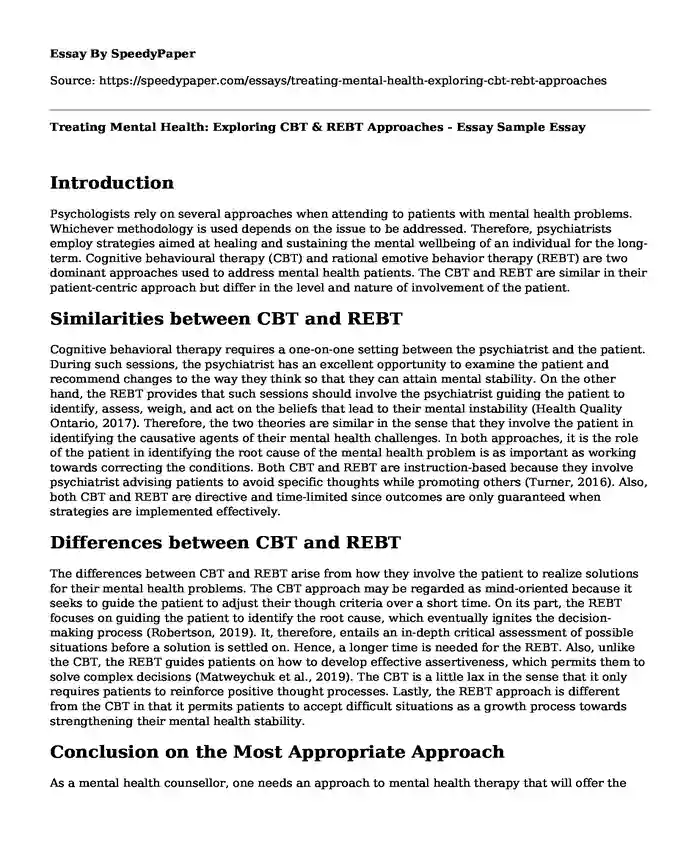
| Type of paper: | Essay |
| Categories: | Psychology Mental health |
| Pages: | 3 |
| Wordcount: | 656 words |
Introduction
Psychologists rely on several approaches when attending to patients with mental health problems. Whichever methodology is used depends on the issue to be addressed. Therefore, psychiatrists employ strategies aimed at healing and sustaining the mental wellbeing of an individual for the long-term. Cognitive behavioural therapy (CBT) and rational emotive behavior therapy (REBT) are two dominant approaches used to address mental health patients. The CBT and REBT are similar in their patient-centric approach but differ in the level and nature of involvement of the patient.
Similarities between CBT and REBT
Cognitive behavioral therapy requires a one-on-one setting between the psychiatrist and the patient. During such sessions, the psychiatrist has an excellent opportunity to examine the patient and recommend changes to the way they think so that they can attain mental stability. On the other hand, the REBT provides that such sessions should involve the psychiatrist guiding the patient to identify, assess, weigh, and act on the beliefs that lead to their mental instability (Health Quality Ontario, 2017). Therefore, the two theories are similar in the sense that they involve the patient in identifying the causative agents of their mental health challenges. In both approaches, it is the role of the patient in identifying the root cause of the mental health problem is as important as working towards correcting the conditions. Both CBT and REBT are instruction-based because they involve psychiatrist advising patients to avoid specific thoughts while promoting others (Turner, 2016). Also, both CBT and REBT are directive and time-limited since outcomes are only guaranteed when strategies are implemented effectively.
Differences between CBT and REBT
The differences between CBT and REBT arise from how they involve the patient to realize solutions for their mental health problems. The CBT approach may be regarded as mind-oriented because it seeks to guide the patient to adjust their though criteria over a short time. On its part, the REBT focuses on guiding the patient to identify the root cause, which eventually ignites the decision-making process (Robertson, 2019). It, therefore, entails an in-depth critical assessment of possible situations before a solution is settled on. Hence, a longer time is needed for the REBT. Also, unlike the CBT, the REBT guides patients on how to develop effective assertiveness, which permits them to solve complex decisions (Matweychuk et al., 2019). The CBT is a little lax in the sense that it only requires patients to reinforce positive thought processes. Lastly, the REBT approach is different from the CBT in that it permits patients to accept difficult situations as a growth process towards strengthening their mental health stability.
Conclusion on the Most Appropriate Approach
As a mental health counsellor, one needs an approach to mental health therapy that will offer the best outcome at realizing and sustaining mental health stability for the patient. Based on the comparisons, the REBT stands out as the most appropriate approach towards realizing long-term wellbeing for the patient. The REBT begins by determining the root cause of the mental health condition. This approach helps to contextualize the problem properly. It also requires that several solutions are considered and that a process that involves evaluating these solutions is utilized. Through insightful evaluation, it then becomes possible to settle on the best strategy for the problem. Thus, REBT offers the best solution when long-term solutions to mental health problems are desired.
References
Health Quality Ontario. (2017). Psychotherapy for major depressive disorder and generalized anxiety disorder: a health technology assessment. Ontario health technology assessment series, 17(15), 1. https://www.ncbi.nlm.nih.gov/pmc/articles/PMC5709536/
Matweychuk, W., DiGiuseppe, R., & Gulyayeva, O. (2019). A comparison of REBT with other cognitive behavior therapies. In Advances in REBT (pp. 47-77). Springer, Cham.
Robertson, D. (2019). The philosophy of cognitive-behavioral therapy (CBT): Stoic philosophy as rational and cognitive psychotherapy. Routledge.
Turner, M. J. (2016). Rational emotive behavior therapy (REBT), irrational and rational beliefs, and the mental health of athletes. Frontiers in psychology, 7, 1423. doi: https://doi.org/10.3389/fpsyg.2016.01423
Cite this page
Treating Mental Health: Exploring CBT & REBT Approaches - Essay Sample. (2023, Sep 17). Retrieved from https://speedypaper.net/essays/treating-mental-health-exploring-cbt-rebt-approaches
Request Removal
If you are the original author of this essay and no longer wish to have it published on the SpeedyPaper website, please click below to request its removal:
- Health Promotion Essay Example
- Paper Sample for Free: Diet and Fitness about Breast Cancer
- Free Essay Offering Solutions to Organ Trafficking
- Other Limitations of the MAP-IT Model as It Relates to My Colleague's Theory. Free Essay
- Paper on Nurse Coaching: Elevating Healthcare Through Empathy and Technical Excellence
- Paper Example on Decision-Making in Nursing: Evidence-Based Practice for Patient Care
- Case Study: Measles
Popular categories




